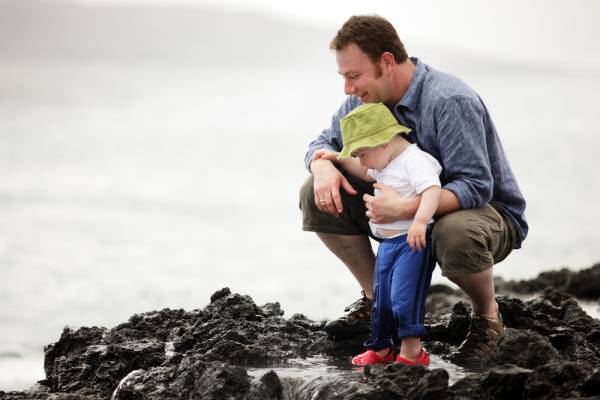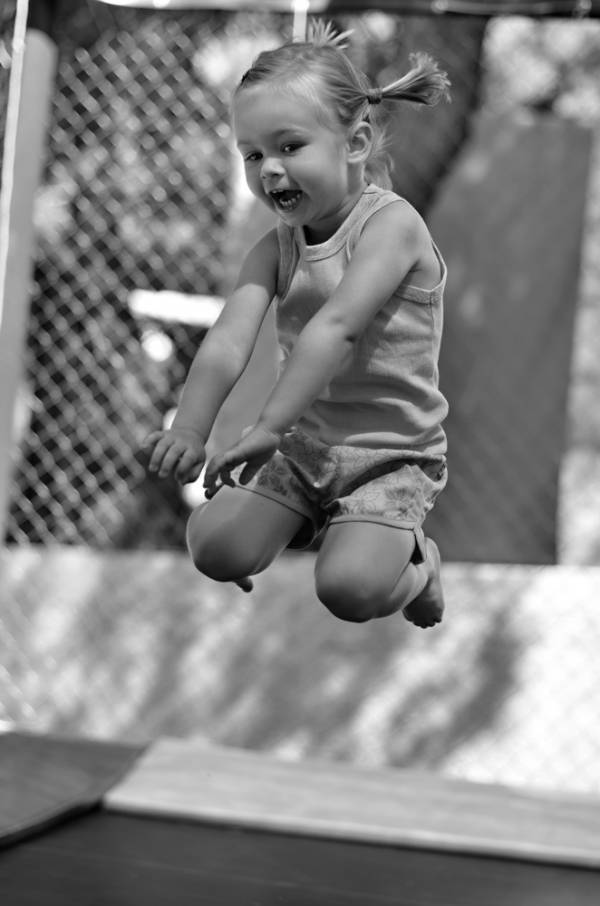Once my firstborn daughter could walk and express herself somewhat coherently, I had a hard time knowing how to teach her anything. I remember being so frustrated when I would try to sit down with her and teach her the ABCs or do a puzzle. Not interested. She’s hard-headed, intelligent, whimsical, and unpredictable, even to this day. I started looking for advice and information about teaching children during the baby/preschool years without the frustration she and I were experiencing.
I had heard about the Montessori method before, and decided to learn more about it. On a whim, I picked up the book The Absorbent Mind, by Maria Montessori, and was totally blown away. This lady knew my daughter, and she knew how to reach her. Since I started integrating Montessori methods into her daily life, I have watched her grow in independence, focus, physical competence, and sweetness.
You might wonder what in the world this has to do with kids’ fitness. Well, I wanted to write an article about some solutions to the growing problem of excess screen time during early childhood, which I explained a bit last week. It’s easy to talk about how we need to get kids moving, but applying that is difficult, particularly during the toddler and preschool years. For me, the Montessori approach has extended into the realm of physical education. Here are five ways I try to keep my children moving and engaged with their physical environment as a mom – although they apply equally to coaches, teachers, and caregivers – inspired by Maria Montessori’s approach to physical education:
1. Create a Moving Classroom
“When mental development is under discussion, there are many who say, ‘How does movement come into it? We are talking about the mind.’ And when we think of intellectual activity, we always imagine people sitting still, motionless. But mental development must be connected with movement and be dependent on it. It is vital that educational theory and practice should be informed by that idea.”
Integrate movement into education. Instead of doing a workbook page about ‘How Sally Gets Dressed in the Morning,’ take your child into her room and let her experiment with buttons, zippers, snaps, and shoelaces. Teach your child about quantity by letting her measure dry beans with real measuring cups. Make the lessons you teach your children, either at home or in a class setting, interactive and movement-based.
2. Explore in Nature
“The child must possess within himself, from birth, a capacity – only a potential at first – of abstracting or taking off from particular things their essential qualities. If you watch carefully any small child, of one to two years old, you will see that he is not only interested in objects as a whole, but also in their qualities, such as roughness, smoothness, hardness, softness, colour, taste, texture, weight, pliability, and so on.”

Exploring nature is a simple way to bring out the little scientist in your child. I love taking my girls on hikes. There really is no better way to take a break from a work day while also giving them some fresh air and renewed energy. Sometimes I teach them about different desert plants beforehand, like cacti varieties that I know we will find on the trail, and see how many we can find during our hike. Right now my oldest daughter is learning to read, so I ask her to find things that begin with certain letters. Playing “I Spy” is another way to keep them engaged in the little details of their environment. These activities keep their minds engaged and active, and distract them from the difficulty of the hike. Also, if you have a 30-pound toddler in a hiking backpack, you’ll get a nice workout.
3. Test Your Child’s Limits
“The gymnasium, therefore, offers a field for the most varied exercises, tending to establish the co-ordination of the movements common in life, such as walking, throwing objects, going up and down stairs, kneeling, rising, jumping, etc.”
Setting up an obstacle course is a great way for young kids to integrate different types of movement. A few months ago I was away at a workshop for the weekend. When I came home, my husband had set up an obstacle course for our girls in the backyard. Although we didn’t have much of a yard for a few weeks, I think my 4-year-old became more coordinated in that amount of time than she had been after all her tumbling classes. He used everyday objects you find around the house or in the yard to make a course that tested a number of skills, including balancing, jumping, crawling, walking backward, and throwing. My daughter’s favorite part (and the most challenging) was running across a 2 x 4 bridge while avoiding the swinging Pampers box – ahem, I mean the ‘Demon Claw’ – and falling into the boiling ‘Demon Water’ below.
4. Work!
“Under the name of educational gymnastics, we include two series of exercises which really form a part of other school work, as, for instance, the cultivation of the earth, the care of plants and animals (watering and pruning the plants, carrying the grain to the chickens, etc.). These activities call for various coordinated movements, as, for example, in hoeing, in getting down to plant things, and in rising; the trips which children make in carrying objects to some definite place, and in making a definite practical use of these objects, offer a field for very valuable gymnastic exercises. The scattering of minute objects, such as corn and oats, is valuable, and also the exercise of opening and closing the gates to the garden and to the chicken yard. All of these exercises are the more valuable in that they are carried on in the open air.”
Maria Montessori believed that children should learn practical tasks from a young age. At 4 years old, our daughter is fully capable of setting and clearing the table, rinsing dishes, matching socks, and many other household chores. Although we don’t live on a farm – someday, we hope – she helps me rake leaves, water plants in the yard, and sweep the patio. Not only do these tasks keep her moving, but they also teach fine motor skills. Because she has been taught from a young age that these things are exciting and fun, she doesn’t see it as drudgery (most of the time) and even looks forward to chore time – although we’ll see how she
feels about it in ten years.

5. Jump Around
“Another piece of gymnasium apparatus, adapted for the broad jump, consists of a low wooden platform painted with various lines, by means of which the distance jumped may be gauged. There is a small flight of stairs which may be used in connection with this plane, making it possible to practise and to measure the high jump.”
I’ve heard from friends that having a trampoline is a great way for young children to release some energy and get exercise. Jumping is commonly used as a therapeutic treatment for children who have sensory processing issues and autism. Although we don’t have a trampoline, both of my daughters enjoy simple jumping games like the one Montessori describes above. Use chalk or another way to measure the jump so your child to see her progress from day to day.
These ideas may come off as simplistic, but I believe that a simple approach is what children require at this age. These are the formative and foundational years. Mastering basic movement skills not only provides a sense of confidence during early childhood, but also fosters a love of movement that will last well into the future.
Photos courtesy of Shutterstock.






